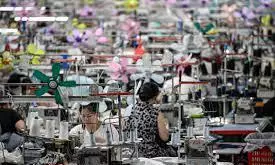
US tariffs and shifting markets threaten China's fast-fashion capital
text_fieldsGuangzhou, long considered the engine of China’s fast-fashion manufacturing sector, is facing mounting pressure from shifting global trade policies and declining international orders.
Once a dependable supplier for Western retailers, the city’s small garment factories are now grappling with uncertainty stemming from escalating tariffs and global instability.
In districts like Panyu and Zengcheng, thousands of migrant workers depend on daily factory jobs to survive. They gather each morning in informal labour markets, hoping to find work stitching garments bound for e-commerce giants. But as one worker explained to The Guardian, “The whole industry is struggling, and now there is a high tariff on Chinese goods because of the trade war. Many foreign clients have decreased their orders from China.”
The U.S.-China trade war, reignited by U.S. President Donald Trump, has particularly impacted exports. Factories that once shipped in bulk to platforms like Shein and Amazon are now seeing orders slashed. Tariffs that peaked at 145% have forced small manufacturers to absorb losses just to stay operational.
“In the recent US-China trade war, if the tariffs go up, we need to lower the production costs to combat it,” said Yang Ruiping, who owns a factory in Panyu. “It leaves little room for profit.”
While Shein's rapid order model once provided a lifeline for small factories, recent changes to U.S. customs policy — specifically the closure of a key low-value import exemption — have started to erode that advantage. Reports suggest prices on Shein rose significantly following the policy shift.
Adding to the pressure, exporters who once relied on alternative markets like Russia now find themselves boxed in by geopolitical instability and reduced demand. “The economy is not doing well anywhere,” said Li Jun, a factory owner who exports denim. “A lot of factories are shutting down.”
For workers paid per piece, long hours are standard, with many reporting only a single rest day per month. “Generally, when we’re talking about the garment industry in China, workers don’t have rest days,” said Li Qiang of China Labor Watch. “They’re paid by piece rate. So they work as much as possible when the orders are still there.”
China’s economic strategy has shifted toward developing high-tech industries, leaving labor-intensive sectors like apparel with reduced support.












